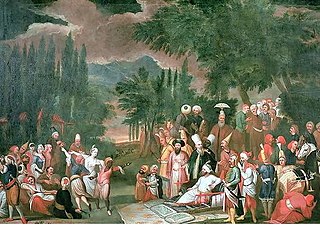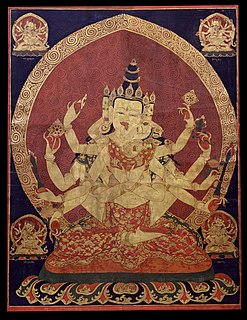
Kaifeng is a prefecture-level city in east-central Henan province, China. It is one of the Eight Ancient Capitals of China, having been the capital seven times in history, and is best known for being the Chinese capital in the Northern Song dynasty.

Amdo is one of the three traditional regions of Tibet, the others being U-Tsang in the west, Kham in the east. Ngari in the north-west was incorporated into Ü-Tsang. Amdo is also the birthplace of the 14th Dalai Lama. Amdo encompasses a large area from the Machu to the Drichu (Yangtze). Amdo is mostly coterminous with China's present-day Qinghai province, but also includes small portions of Sichuan and Gansu provinces.

Toghon Temür, also known by the temple name Huizong bestowed by the Northern Yuan dynasty in Mongolia and by the posthumous name Emperor Shun bestowed by the Hongwu Emperor of the Ming dynasty China, was a son of Khutughtu Khan Kusala who ruled as emperor of the Yuan dynasty. Apart from Emperor of China, he is also considered the last Khagan of the Mongol Empire.
Emperor Gong of Song, personal name Zhao Xian, was the 16th emperor of the Song dynasty in China and the seventh emperor of the Southern Song Dynasty. The sixth son of his predecessor, Emperor Duzong, Zhao Xian came to the throne around the age of four, and reigned for less than two years before he was forced to abdicate in 1276. He was succeeded by his fifth brother, Zhao Shi, enthroned as Emperor Duanzong.

Sino-Mongols, are citizens of the People's Republic of China who are ethnic Mongols. They form one of the 55 ethnic minorities officially recognized by the People's Republic of China. There are approximately 5.8 million people classified as ethnic Mongols living in China. Most of them live in Inner Mongolia, Northeast China, Xinjiang, etc. The Mongol population in China is nearly twice as much as that of the sovereign state of Mongolia.

The Shatuo were a Turkic tribe that heavily influenced northern Chinese politics from the late ninth century through the tenth century. They are noted for founding three, Later Tang, Later Jin, and Later Han, of the five dynasties and one, Northern Han, of the ten kingdoms during the Five Dynasties and Ten Kingdoms period. The short lived kingdoms founded by Shatuo Turks would later be conquered by the Song dynasty. After the Han Chinese conquest of Shatuo Turks, they mostly disappeared as an ethnic group.

Mongolia under Qing rule was the rule of the Qing dynasty over the Mongolian steppe, including the Outer Mongolian 4 aimags and Inner Mongolian 6 leagues from the 17th century to the end of the dynasty. "Mongolia" here is understood in the broader historical sense. The last Mongol Khagan Ligden saw much of his power weakened in his quarrels with the Mongol tribes, was defeated by the Later Jin dynasty, and died soon afterwards. His son Ejei Khan gave Hong Taiji the imperial authority, ending the rule of Northern Yuan dynasty then centered in Inner Mongolia by 1635. However, the Khalkha Mongols in Outer Mongolia continued to rule until they were overrun by the Dzungar Khanate in 1690, and they submitted to the Qing dynasty in 1691.

The exact nature of relations between Tibet and the Ming dynasty of China (1368–1644) is unclear. Analysis of the relationship is further complicated by modern political conflicts and the application of Westphalian sovereignty to a time when the concept did not exist. The Historical Status of China's Tibet, a book published by the government of PRC, asserts that the Ming dynasty had unquestioned sovereignty over Tibet, pointing to the Ming court's issuing of various titles to Tibetan leaders, Tibetans' full acceptance of these titles, and a renewal process for successors of these titles that involved traveling to the Ming capital. Scholars within China also argue that Tibet has been an integral part of China since the 13th century and that it was thus a part of the Ming Empire. But most scholars outside China, such as Turrell V. Wylie, Melvin C. Goldstein, and Helmut Hoffman, say that the relationship was one of suzerainty, that Ming titles were only nominal, that Tibet remained an independent region outside Ming control, and that it simply paid tribute until the Jiajing Emperor (1521–1566), who ceased relations with Tibet.

The Mongol conquest of the Jin dynasty, also known as the Mongol–Jin War, was fought between the Mongol Empire and the Jurchen-led Jin dynasty in Manchuria and north China. The war, which started in 1211, lasted over 23 years and ended with the complete conquest of the Jin dynasty by the Mongols in 1234.
Tai Situ Changchub Gyaltsen was a key figure in Tibetan History. He was the founder of the Phagmodrupa Dynasty which replaced the old Mongol-backed Sakya regime, ending the Tibet under Yuan rule. He ruled most of Tibet as desi (regent) from 1354 to 1364, and as a law-giver, politician and religious patron, he created a heritage that lasted for centuries.

The Phagmodrupa dynasty or Pagmodru was a dynastic regime that held sway over Tibet or parts thereof from 1354 to the early 17th century. It was established by Tai Situ Changchub Gyaltsen of the Lang family at the end of the Yuan dynasty. The dynasty had a lasting importance on the history of Tibet; it created an autonomous kingdom after Mongol rule, revitalized the national culture, and brought about a new legislation that survived until the 1950s. Nevertheless, the Phagmodrupa had a turbulent history due to internal family feuding and the strong localism among noble lineages and fiefs. Its power receded after 1435 and was reduced to Ü in the 16th century due to the rise of the ministerial family of the Rinpungpa. It was defeated by the rival Tsangpa dynasty in 1613 and 1620, and was formally superseded by the Ganden Phodrang regime founded by the 5th Dalai Lama in 1642. In that year, Güshi Khan of the Khoshut formally transferred the old possessions of Sakya, Rinpung and Phagmodrupa to the "Great Fifth".

The Yuan dynasty, officially the Great Yuan, was a successor state to the Mongol Empire after its division and a ruling dynasty of China established by Kublai Khan, leader of the Mongol Borjigin clan, lasting from 1271 to 1368. In Chinese historiography, this dynasty followed the Song dynasty and preceded the Ming dynasty.

The Northern Yuan was a dynastic regime ruled by the Mongol Borjigin clan based in the Mongolian Plateau. It operated as a rump state after the collapse of the Yuan dynasty of China in 1368 and lasted until its conquest by the Jurchen-led Later Jin dynasty in 1635. The Northern Yuan dynasty began with the end of Yuan rule in China proper and the retreat of the Yuan remnants led by Toghon Temür to the Mongolian steppe. This period featured factional struggles and the often only nominal role of the Great Khan.
The Upper Mongols, also known as the Köke Nuur Mongols or Qinghai Mongols, are ethnic Mongol people of Oirat and Khalkha origin who settled around Qinghai Lake in so-called Upper Mongolia. As part of the Khoshut Khanate of Tsaidam and the Koke Nuur they played a major role in Sino–Mongol–Tibetan politics during the 17th and 18th centuries. The Upper Mongols adopted Tibetan dress and jewelry despite still living in the traditional Mongolian ger and writing in the script.

There were several Mongol invasions of Tibet. The earliest is the alleged plot to invade Tibet by Genghis Khan in 1206, which is considered anachronistic; there is no evidence of Mongol-Tibetan encounters prior to the military campaign in 1240. The first confirmed campaign is the invasion of Tibet by the Mongol general Doorda Darkhan in 1240, a campaign of 30,000 troops that resulted in 500 casualties. The campaign was smaller than the full-scale invasions used by the Mongols against large empires. The purpose of this attack is unclear, and is still in debate among Tibetologists. Then in the late 1240s Mongolian prince Godan invited Sakya lama Sakya Pandita, who urged other leading Tibetan figures to submit to Mongol authority. This is generally considered to have marked the beginning of Mongol rule over Tibet, as well as the establishment of patron and priest relationship between Mongols and Tibetans. These relations were continued by Kublai Khan, who founded the Mongol Yuan dynasty and granted authority over whole Tibet to Drogon Chogyal Phagpa, nephew of Sakya Pandita. The Sakya-Mongol administrative system and Yuan administrative rule over the region lasted until the mid-14th century, when the Yuan dynasty began to crumble.

Tibet under Yuan rule refers to the Yuan dynasty's rule over Tibet from approximately 1270 to 1354. During the Yuan rule of Tibet, the region was structurally, militarily and administratively controlled by the Mongol-led Yuan dynasty of China, a division of the Mongol Empire. In the history of Tibet, Mongol rule was established after Sakya Pandita got power in Tibet from the Mongols in 1244, following the 1240 Mongol conquest of Tibet led by the Mongol general with the title doord darkhan. It is also called the Sakya dynasty after the favored Sakya school of Tibetan Buddhism.
Buddhism was first actively disseminated in Tibet from the 6th to the 9th century CE, predominantly from India. During the Era of Fragmentation, Buddhism waned in Tibet, only to rise again in the 11th century. With the Mongol invasion of Tibet in the 13th century and the establishment of the Mongol Yuan dynasty, Tibetan Buddhism spread beyond Tibet to Mongolia and China. From the 14th to the 20th Tibetan Buddhism was patronized by the Chinese Ming dynasty (1368–1644) and the Manchurian Qing dynasty (1644–1912).
The Imperial Preceptor, or Dishi was a high title and powerful post created by Kublai Khan, founder of the Yuan dynasty. It was established as part of Mongol patronage of Tibetan Buddhism and Yuan administrative rule of Tibet.

The Yuan dynasty was a vast empire founded by Mongol leader Kublai Khan in China. During its existence, its territory was divided into the Central Region (腹裏) governed by the Central Secretariat and places under control of various provinces (行省) or Branch Secretariats (行中書省), as well as the region under the Bureau of Buddhist and Tibetan Affairs. In addition, the Yuan emperors held nominal suzerainty over the western Mongol khanates, but in reality none of them were governed by the Yuan dynasty due to the division of the Mongol Empire.

This article summarizes the History of the eastern steppe, the eastern third of the Eurasian Steppe, that is, the grasslands of Mongolia and northern China. It is a companion to History of the central steppe and History of the western steppe. Most of its recorded history deals with conflicts between the Chinese and the steppe nomads. Most of the sources are Chinese.














